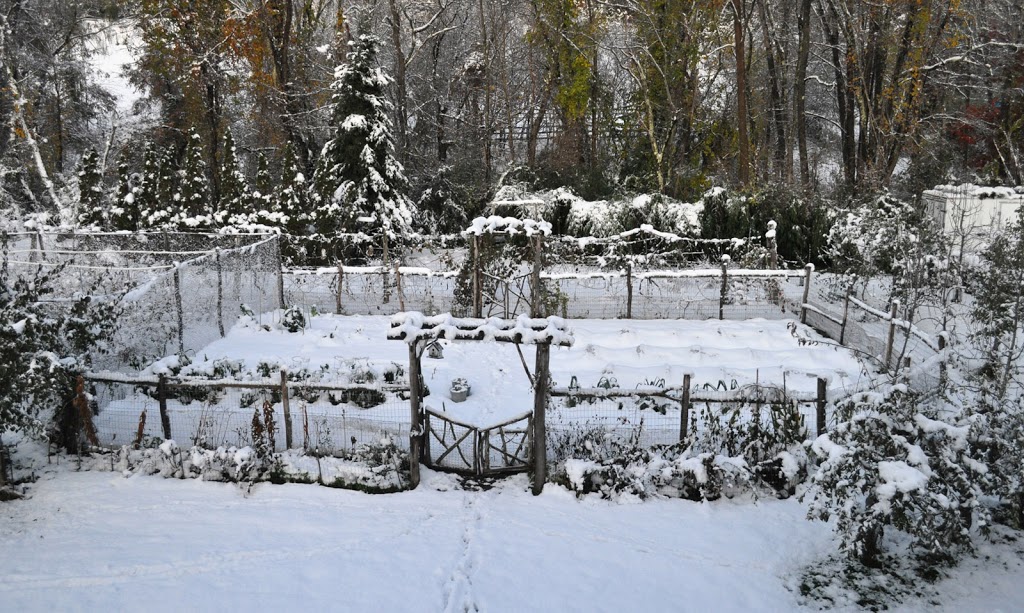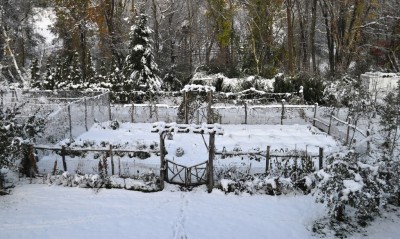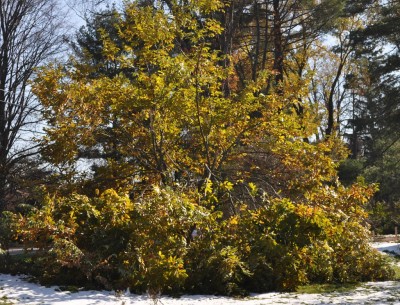UNCOMMON FRUIT, COMMON FRUIT, CATERPILLAR HEDGE
/2 Comments/in Gardening/by Lee A. ReichWith the economy the way it is, forget about any hedges against inflation. Anyway, I’m more concerned about hedges against poor harvests, and that hedge is to grow a diversity fruits and vegetables. I’ve never had a year of poor harvests of everything. Cabbage and broccoli will revel in a cool summer during which peppers or melons hardly ripen. Bean beetles that might ravage green beans won’t touch tomatoes, okra, and other vegetables; they won’t even nibble soybeans.
Besides offering a hedge, that diversity also usually presents me with a spectrum of flavors and nutrition.
In fruits, 2011 was a particularly good year for pears and hardy and super-hardy kiwifruit. These kiwifruis are grape-sized, smooth-skinned cousins to the fuzzy kiwifruit of our markets. The flavor is similar, but better, and you pop the whole fruit into your mouth, skin and all. The plants are strong-growing vines, so pretty that they were for decades planted strictly as ornamentals, their gustatory treasures lying hidden behind leaves and ignored. In contrast to fuzzy kiwifruits, hardy and super-hardy kiwifruits can be grown just about everywhere.
Super-hardy kiwifruits, Actinidia kolomikta (“super-hardy” because they tolerate cold to minus 40°), ripened back in early August and hardy kiwifruit, A. arguta (hardy to minus 25°F.), started ripening in mid September. You know these fruits are ripe for picking when the first berries just begin to soften.
I harvested all my hardy kiwifruits once the first ones ripened. Some were firm and some were ready to eat. Kept under refrigeration, the firm ones slowly ripen; at room temperature, they ripen faster. Ripened berries have been, and will be, for a few more weeks, a colorful, sweet-tart, flavorful addition to morning cereal.
———————————-
Apple trees have never borne well here. The reason is because I am trying to grow them “organically.” That means giving special care to the soil, keeping it nourished with compost, leaf mold, wood chips, and seaweed. That means maintaining a diversity of flowering plants to attract beneficial insects. And it means minimum or no spraying of pesticides which, if needed have minimum impact on everything but the target pest(s).
Admittedly, my farmden is not ideal for apple growing. Six-thousand acres of woods (not mine, Mohonk’s), overwintering home to many pests, lie within 50 feet of my trees. And cold air settles into this floodplain of the Wallkill River, so morning fogs and dews linger longer than on higher ground to fester disease problems. So I do spray my trees, many times each season, with Surround (a commercial formulation of kaolin clay) and sulfur (a naturally mined mineral).
The apple trees looked so hopeful in the spring. No late frosts. Exuberant, new growth. Pea-sized fruitlets rapidly swelling to marble-size, then golfball-size, and larger.
But something, some things, happened between those halcyon days of June and harvest. Fruits disappeared, dropped, became ugly with blotches and dimples. My farmden isn’t the only one to suffer such affronts. Basically, if you wanted to pick the hardest fruit to grow in eastern U.S., what fruit would that be? Apple! Why? Because of a very few, but very serious insect and disease problems. Plum curculio, codling moth, apple maggot, apple scab, fire blight, cedar-apple rust, and powdery mildew are the culprits.)
Still, I haven’t thrown in the towel yet with apples. I noted this year that more attention is needed to late summer diseases, such as black rot and bitter rot. And the apples I do harvest might be few, but their flavors are supreme, in large part because of variety selection and perhaps due to terroir.
Apples are not the only fruit worth growing around here. Even if the apple crop is poor, this year I had and have plenty of, in addition to pears and kiwifruits, medlars, raspberries, and grapes. And every year seems to be a good one for pawpaws, persimmons, and blueberries. I’ll be digging into the 40 quarts of blueberries in the freezer just as soon as the last of the kiwifruits are finished.
——————————-
And speaking of hedges, green ones, my yew caterpillar is going into winter looking better than ever. This hedge started out as 4 boring yew bushes planted about 25 years ago and needing multiple prunings each growing season to prevent their overwhelming nearby windows, or even the whole house.
Inspired by Keith Buesing’s (of Gardiner, NY) fabulous green sculptures, a couple of years ago I began re-forming the yews. Yew is an adaptable plant, amenable to pretty much all manners of pruning, and the reformation is now pretty much complete. (The smiling mouth is still under construction.)
Multiple prunings are still needed each growing season, but they are mostly light cuts to polish and maintain the form.
With the economy the way it is, forget about any hedges against inflation. Anyway, I’m more concerned about hedges against poor harvests, and that hedge is to grow a diversity fruits and vegetables. I’ve never had a year of poor harvests of everything. Cabbage and broccoli will revel in a cool summer during which peppers or melons hardly ripen. Bean beetles that might ravage green beans won’t touch tomatoes, okra, and other vegetables; they won’t even nibble soybeans.
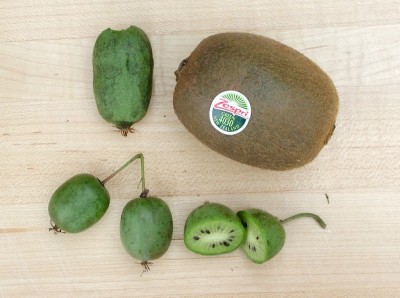 |
| One thing I like about my kiwis, besides great flavor, is that they don’t have those obnoxious plastictags on them. |
Besides offering a hedge, that diversity also usually presents me with a spectrum of flavors and nutrition.
In fruits, 2011 was a particularly good year for pears and hardy and super-hardy kiwifruit. These kiwifruis are grape-sized, smooth-skinned cousins to the fuzzy kiwifruit of our markets. The flavor is similar, but better, and you pop the whole fruit into your mouth, skin and all. The plants are strong-growing vines, so pretty that they were for decades planted strictly as ornamentals, their gustatory treasures lying hidden behind leaves and ignored. In contrast to fuzzy kiwifruits, hardy and super-hardy kiwifruits can be grown just about everywhere.
Super-hardy kiwifruits, Actinidia kolomikta (“super-hardy” because they tolerate cold to minus 40°), ripened back in early August and hardy kiwifruit, A. arguta (hardy to minus 25°F.), started ripening in mid September. You know these fruits are ripe for picking when the first berries just begin to soften.
I harvested all my hardy kiwifruits once the first ones ripened. Some were firm and some were ready to eat. Kept under refrigeration, the firm ones slowly ripen; at room temperature, they ripen faster. Ripened berries have been, and will be, for a few more weeks, a colorful, sweet-tart, flavorful addition to morning cereal.
———————————-
Apple trees have never borne well here. The reason is because I am trying to grow them “organically.” That means giving special care to the soil, keeping it nourished with compost, leaf mold, wood chips, and seaweed. That means maintaining a diversity of flowering plants to attract beneficial insects. And it means minimum or no spraying of pesticides which, if needed have minimum impact on everything but the target pest(s).
Admittedly, my farmden is not ideal for apple growing. Six-thousand acres of woods (not mine, Mohonk Preserve’s), overwintering home to many pests, lie within 50 feet of my trees. And cold air settles into this floodplain of the Wallkill River, so morning fogs and dews linger longer than on higher ground to fester disease problems. So I do spray my trees, many times each season, with Surround (a commercial formulation of kaolin clay) and sulfur (a naturally mined mineral).
The apple trees looked so hopeful in the spring. No late frosts. Exuberant, new growth. Pea-sized fruitlets rapidly swelling to marble-size, then golfball-size, and larger.
Still, I haven’t thrown in the towel yet with apples. I noted this year that more attention is needed to late summer diseases, such as black rot and bitter rot. And the apples I do harvest might be few, but their flavors are supreme, in large part because of variety selection and perhaps due to terroir.
Apples are not the only fruit worth growing around here. Even if the apple crop is poor, this year I had and have plenty of, in addition to pears and kiwifruits, medlars, raspberries, and grapes. And every year seems to be a good one for pawpaws, persimmons, and blueberries. I’ll be digging into the 40 quarts of blueberries in the freezer just as soon as the last of the kiwifruits are finished.
——————————-
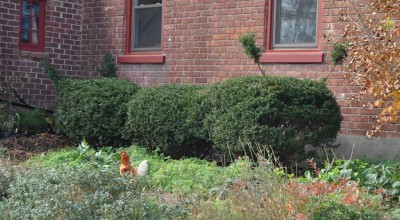 And speaking of hedges, green ones, my yew caterpillar is going into winter looking better than ever. This hedge started out as 4 boring yew bushes planted about 25 years ago and needing multiple prunings each growing season to prevent their overwhelming nearby windows, or even the whole house.
And speaking of hedges, green ones, my yew caterpillar is going into winter looking better than ever. This hedge started out as 4 boring yew bushes planted about 25 years ago and needing multiple prunings each growing season to prevent their overwhelming nearby windows, or even the whole house. Inspired by Keith Buesing’s (of Gardiner, NY) fabulous green sculptures, a couple of years ago I began re-forming the yews. Yew is an adaptable plant, amenable to pretty much all manners of pruning, and the reformation is now pretty much complete. (The smiling mouth is still under construction.)
Multiple prunings are still needed each growing season, but they are mostly light cuts to polish and maintain the form.
WINTER, ALREADY IT SEEMS
/2 Comments/in Gardening/by Lee A. ReichWinter seemed to have begun all of a sudden on October 29th when, after weeks of balmy autumn weather, large flakes poured out of the sky to bury lush green lettuces, leeks, Chinese and Occidental cabbages, and radishes beneath a heavy, white blanket. The next night, temperatures plummeted to below 20°F.
Thanks to modern weather reporting, I was ready. Before the snow fell, I set arches of 5-foot-long wire at 4-foot intervals over some of the vegetable beds. On top of these wire hoops went a layer of row cover fabric, which lets in some light and affords a few extra degrees of cold protection, topped by clear plastic for even more protection from cold. More wire arches at the same locations as the first set of hoops sandwiched the plastic and row cover material to keep everything secure. Vegetables are accessible by merely sliding the plastic sides up.
As for lettuces, leeks, Chinese and Occidental cabbages, and radishes that remained open to the elements, they fared well also, remaining crisp and protected from freezing beneath a snowy blanket.
Depending on the vegetable and what protection it’s afforded, the garden should provide salad fixings and greens at least through the end of this month. After that, it’s on to the 5 foot square cold frame that’s filled with almost 3 dozen heads of Romaine lettuce just waiting to be picked. And then it’s on into the greenhouse.
————————————–
So many plants, so little space. Potted plants, that is. Roots, which have evolved in the relative warmth of the earth, can’t tolerate as much cold as trunks and branches. So roots in pots experience colder temperatures than roots in the ground. Before the snow and cold weather descended, I began frantically moving all my potted plants to shelter.
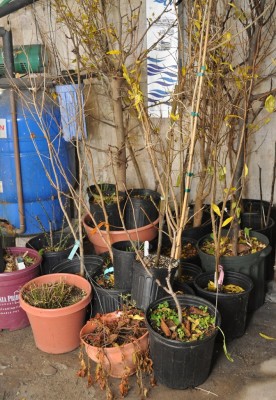 My cold-hardy, potted plants, a miscellany that includes a flowering dogwood, a fantail willow, Japanese hollies, aborvitaes, some roses, and black currants, got shoved right up against the north wall of my brick house. With some mulch thrown up to the rims of the pots and snow cover that slides off the roof, plants there weather winter well. (The reason these hardy plants are in pots is because I haven’t yet figured out where to plant them; more homeless plants always seem to come my way every year.)
My cold-hardy, potted plants, a miscellany that includes a flowering dogwood, a fantail willow, Japanese hollies, aborvitaes, some roses, and black currants, got shoved right up against the north wall of my brick house. With some mulch thrown up to the rims of the pots and snow cover that slides off the roof, plants there weather winter well. (The reason these hardy plants are in pots is because I haven’t yet figured out where to plant them; more homeless plants always seem to come my way every year.)My subtropical plants need more protection because their trunks and branches don’t tolerate cold below about 25°F. I weeded and trimmed back some branches of potted figs, pomegranates, an olive tree, a couple of pineapple guavas, some black mulberries, and a che, and bound the remaining branches together with string. Stripping off any remaining leaves helped put the plants to sleep.
A couple of rose plants also joined this mostly Mediterranean crowd. The roses are hardy but they are particularly luscious-looking David Austen varieties I need to have available in late winter to force blossoms for a very very special wedding at the end of May.
Finally, the roses and other plants each then had to be wrestled down the narrow stairs to my barely heated basement. The plants crowded in down there might be those you’d find along the Mediterranean, but the dank, dark scene there is decidedly non-Mediterranean.
——————————–
Mother Nature usually calls the shots. Fifteen years ago I transplanted a chestnut seedling into my south field. With time, I helped Mother Nature along, coaxed the tree with pruning shears and saws to develop a pleasing and sturdy form.
Major limbs radiating out at wide angles indicate good anchorage to the trunk; I had selected these limbs as “keepers” in their youth. I had lopped off any young branches originating closer together vertically than a foot or two apart, even though, to the untrained eye, the developing tree then looked sparsely branched in its youth. This wide spacing allowed each limb to develop without interference as it swelled to 4 and then 6 inches in diameter. I also had favored keeping only those young shoots that originated in a spiral pattern up the trunk, again to minimize competition for nutrients pumped up from below and from sunlight falling from above.
The tree grew rapidly, after 15 years achieving a height and girth of 25 feet.
The recent snowfall made light of my efforts. Snow clinging to leafy branches bowed limbs towards the ground at angles beyond which early good training could sustain. They broke. Almost half of the once fully rounded crown ended up with a skirt of leafy branches ground level and, higher up, splintered stubs of broken limbs stared out.
The sight is not as upsetting to me as might be imagined. Chestnuts are fast growing trees. Within three years, the tree will be well on its way to symmetrical elegance again.
Also, this past spring I had done myself more cleanly what Mother Nature chose to do: I had lopped back two sturdy limbs to within a foot of the trunk. On the remaining stubs I grafted stems of two named varieties of chestnut hybrids notable for their particularly large and flavorful nuts. The grafted stems spent the summer knitting to the stubs and growing out into long shoots. Because those shoots were shaded by overhanging limbs, my plan was to lop back some upper limbs next spring to let those young, grafted shoots bask in sunlight.
Mother Nature got the jump on me with an admittedly much freer hand. I’ll soon trim those splintered stubs back to well placed side branches so that the stubs heal quickly and cleanly to limit the possibility of diseases.




